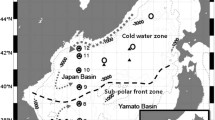Abstract
OCEANIC dissolved organic carbon (DOC) is one of the Earth's largest carbon reservoirs, but until recently its role in the carbon cycle has been neglected. New methodology1, however, has led to larger estimates of DOC concentrations and also to renewed interest in the biochemical lability of DOC2. Previous work found that the mean age of DOC in the surface ocean was > 1,000 years3. To examine the lability of DOC in greater detail, we have conducted experiments to estimate DOC turnover rates in the upper ocean. We directly observed rapid DOC turnover by bacterioplank-ton during the spring phytoplankton bloom in the North Atlantic ocean. Potential turnover rates, measured in 0.8-um filtered samples, ranged from 0.025 to 0.363 per day, and were consistent with bacterial biomass production and uptake of dissolved nitrogen (NH+4, NO-3 and urea). Our results indirectly suggest that cycling of dissolved organic nitrogen (DON) differs from that of DOC. The high estimates of DOC concentrations and turnover rates repeated here, if found to be general, would seem to demand changes in models4 of carbon cycling and of the ocean's role in buffering increases in atmospheric CO2.
Similar content being viewed by others
References
Sigumura, Y. & Suzuki, Y. Mar. Chem. 24, 105–131 (1988).
Toggweiler, J. R. Nature 334, 468 (1988).
Williams, P. M. & Druffel, E. R. M. Nature 330, 246–248 (1987).
Toggweiler, J. R. Productivity of the Ocean: Present and Past (eds Berger, W. H. et al.) 65–84 (Wiley, New York, 1989).
Ducklow, H. W. Oceanogr. Mag. 2, 4–8 (1989).
Hobbie, J. E. et al. Appl. envir. Microbiol. 33, 1223–1228 (1977).
Landry, M. R. & Hassett, R. P. Mar. Biol. 16, 283–288 (1982).
Ducklow, H. W. & Hill, S. M. Limnol. Oceanogr. 30, 239–259 (1985).
Taylor, G. T. et al. Mar. Ecol. Prog. Ser. 23, 129–141 (1985).
Barber, R. T. Nature 220, 274–275 (1968).
Ogura, N. Mar. Biol. 13, 89–93 (1972).
Williams, P. J. leB. Chemical Oceanography (eds Riley, J. P. & Skirrow, G.) 301–363 (Academic, London, 1975).
Wheeler, P. A. & Kirchman, D. L. Limnol. Oceanogr. 31, 998–1009 (1986).
Meyer, J. L. et al. Microbiol. Ecol. 13, 13–29 (1987).
Bjørnsen, P. K. Mar. Ecol. Prog. Ser. 30, 191–196 (1986).
Williams, P. J. leB. Kiel. Meeresforsch. 5, 1–28 (1981).
Fuhrman, J. A. Mar. Ecol. Prog. Ser. 66, 197–203 (1990).
Sharp, J. H. Nitrogen in the Marine Environment (eds Carpenter, E. J. & Capone, D. G.) 1–35 (Academic, New York, 1983).
Duursma, E. K. Neth. J. Sea Res. 1, 3–190 (1961).
Keil, R. G. & Kirchman, D. L. Mar. Ecol. Prog. Ser. 73, 1–10 (1991).
Kirchman, D. L. et al. Deep-Sea Res. 36, 1763–1776 (1989).
Jackson, G. A. & Williams, P. M. Deep-Sea Res. 32, 223–235 (1985).
Ittekkot, V. et al. Mar. Ecol. Prog. Ser. 4, 299–305 (1981).
Kirchman, D. L. et al. Limnol. Oceanogr 35, 1258–1266 (1990).
Parsons, T. R. et al. Mar. envir. Res. 4, 229–242 (1980/1981).
Suzuki, Y. et al. Mar. Chem. 16, 83–97 (1985).
Nagata, T. & Watanabe, Y. Appl. envir. Microbiol. 56, 1303–1309 (1990).
Bratbak, G. Appl. envir. Microbiol. 33, 1488–1493 (1985).
Whitledge, T. E. et al. Automated Nutrient Analyses in Seawater, Brookhaven Natl. Lab. Publ. No. 51398 (Department of Energy and Environment, Upton, New York, 1981).
Author information
Authors and Affiliations
Rights and permissions
About this article
Cite this article
Kirchman, D., Suzuki, Y., Garside, C. et al. High turnover rates of dissolved organic carbon during a spring phytoplankton bloom. Nature 352, 612–614 (1991). https://doi.org/10.1038/352612a0
Received:
Accepted:
Issue Date:
DOI: https://doi.org/10.1038/352612a0
- Springer Nature Limited
This article is cited by
-
Microbial degradation of various types of dissolved organic matter in aquatic ecosystems and its influencing factors
Science China Earth Sciences (2023)
-
Production of dissolved organic carbon in the South China Sea: A modeling study
Science China Earth Sciences (2022)
-
Microfluidic and mathematical modeling of aquatic microbial communities
Analytical and Bioanalytical Chemistry (2021)
-
Characterization of the bacterioplankton community and the influencing factors in the upper reaches of the Han River basin
Environmental Science and Pollution Research (2021)
-
Rapid microbial diversification of dissolved organic matter in oceanic surface waters leads to carbon sequestration
Scientific Reports (2020)





